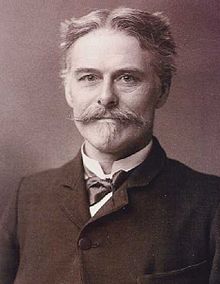Our website is made possible by displaying online advertisements to our visitors.
Please consider supporting us by disabling your ad blocker.
Edward Drinker Cope
Edward Drinker Cope | |
|---|---|
 | |
| Born | July 28, 1840 Philadelphia, Pennsylvania, U.S. |
| Died | April 12, 1897 (aged 56) Philadelphia, Pennsylvania, U.S. |
| Education | University of Pennsylvania |
| Known for | Cope's rule |
| Spouse | Annie Pim |
| Children | Julia Biddle Cope |
| Awards |
|
| Scientific career | |
| Fields | Paleontology, zoology, herpetology |
| Institutions | United States Geological Survey, Haverford College |
| Influences | Joseph Leidy |
| Author abbrev. (zoology) | Cope |
| Signature | |

Edward Drinker Cope (July 28, 1840 – April 12, 1897) was an American biologist. He was notable for his work on fossil animals of North America.[1] Cope was born in Philadelphia, Pennsylvania.
Cope was a paleontologist, comparative anatomist, herpetologist and ichthyologist. He wrote many papers. His parents were rich Quakers.
His father wanted him to be a farmer, but he became a scientist. He married his cousin. Later, they owned a museum in Philadelphia.
Mostly, he read books on his own to learn science and found things out himself. He was not a teacher. He did field work, and wrote a lot. In the 1870s and 1880s, went to the American West to report what the land was like to the government. He was often on a mapping team sent by the United States Geological Survey.
For a while he and Othniel Charles Marsh were competing to find dinosaurs. This fight between them is called the Bone Wars. Sometimes being a scientist cost him more money than he could afford. In the 1880s, Cope lost so much money in his silver mines that he had to sell a lot of his fossil collection in 1886. In the 1890s, he was no longer poor, but he died when he was only 57.
1,400 of his articles were published in science journals. He found over 1,000 species of extinct animals. He wrote about hundreds of kinds of ancient fish. He found dozens of dinosaurs. He wrote about the evolution of mammalian molars teeth, and produced two huge works on the amphibia and reptiles of North America.
Cope showed that horses evolved to be larger as they moved from woodland onto grassland. The fact that the fossils show the mammals getting bigger over time is called Cope's rule.
- ↑ Cope's middle name, Drinker, was his grandmother’s maiden name.
Previous Page Next Page


